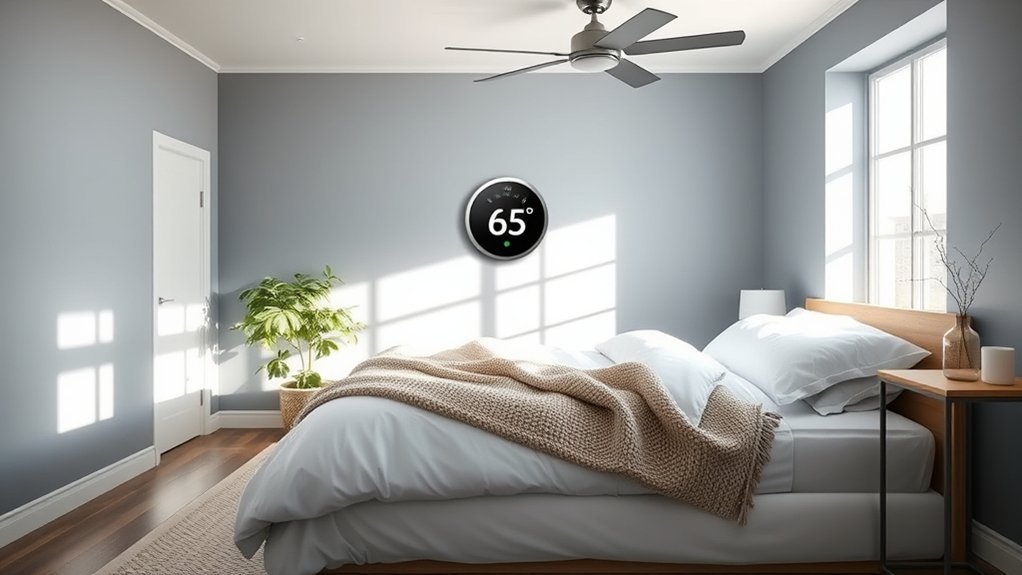When it comes to achieving that perfect sleep oasis, many factors play a role in your overall comfort. You might find yourself wondering about the best mattress for your sleep position or how to choose the right pillow to support your neck. Understanding these elements can lead to a significant improvement in your sleep quality. So, what should you consider to create an environment that promotes restful, rejuvenating slumber?
Choosing the Right Mattress

Choosing the right mattress is essential for a good night’s sleep, and with countless options available, it can feel overwhelming.
Start by considering your sleep position; side sleepers often benefit from softer, contouring mattresses, while back and stomach sleepers may need firmer support.
Look for materials that suit your preferences—memory foam offers pressure relief, while innerspring mattresses provide bounce and breathability.
Consider your material preferences: memory foam for pressure relief or innerspring for added bounce and breathability.
Pay attention to firmness levels, as they can greatly affect your spine alignment and overall comfort.
Don’t forget to test mattresses in-store, if possible, or take advantage of trial periods.
Remember, investing in a quality mattress can profoundly impact your sleep quality, mood, and health.
Prioritize your needs, and you’ll find the perfect fit for restful nights.
Best Pillow Types for Sleep Support

What’s the secret to finding a pillow that truly supports your sleep? It’s all about understanding your sleep position and personal preferences.
For side sleepers, a thicker memory foam or latex pillow can help fill the gap between your shoulder and head, aligning your spine.
Back sleepers often benefit from a medium loft pillow, providing adequate support without forcing the neck into an awkward angle.
Stomach sleepers should opt for a soft, low-profile pillow to prevent neck strain.
Additionally, consider materials; hypoallergenic options like bamboo or cooling gel can enhance comfort.
Remember, the right pillow can greatly improve your sleep quality, reducing aches and fostering restorative rest.
Prioritize your needs to find the perfect match!
Ideal Room Temperature for Sleep

Finding the ideal room temperature for sleep can greatly enhance your rest and overall well-being. Research suggests that a cooler environment is generally more conducive to a good night’s sleep. Aim for a temperature between 60°F to 67°F (15°C to 19°C).
Here are some tips to help you achieve that:
- Use breathable bedding materials.
- Invest in a quality fan or air conditioner.
- Keep curtains or blinds closed during the day.
- Consider a smart thermostat for easy adjustments.
- Experiment with your mattress’s insulation properties.
The Role of Bedding in Comfort
While you mightn’t realize it, the type of bedding you use can greatly impact your sleep comfort. Quality sheets, blankets, and pillows play an important role in regulating your body temperature and providing support.
For instance, breathable materials like cotton and bamboo wick moisture away, keeping you cool throughout the night. Conversely, synthetic fabrics may trap heat, leading to discomfort.
Additionally, the right pillow is essential for spinal alignment and reducing neck pain. A supportive mattress also contributes greatly, as it can prevent pressure points that disrupt sleep.
Tips for Creating a Sleep-Friendly Environment
Creating a sleep-friendly environment goes hand in hand with choosing the right bedding. To improve your sleep experience, focus on these essential elements:
- Optimal Temperature: Keep your bedroom cool, ideally between 60-67°F (15-19°C).
- Lighting Control: Use blackout curtains to block out light and consider dimming lights in the evening.
- Noise Reduction: Minimize disturbances with earplugs or a white noise machine.
- Air Quality: Maintain proper ventilation; consider using an air purifier to reduce allergens.
- Comfortable Layout: Arrange furniture to promote relaxation and ease of movement, avoiding clutter.
Frequently Asked Questions
How Does Sleep Position Affect Mattress Choice?
Your sleep position greatly influences your mattress choice. Side sleepers need softer mattresses for pressure relief, while back and stomach sleepers often benefit from firmer options that provide better support and spinal alignment during rest.
Can Diet Impact Sleep Quality and Comfort?
Yes, your diet markedly impacts sleep quality and comfort. Consuming heavy meals, caffeine, or alcohol close to bedtime can disrupt your sleep cycle, while a balanced diet promotes restful sleep and overall well-being.
What Are the Effects of Screen Time on Sleep?
Excessive screen time can disrupt your sleep by increasing alertness and reducing melatonin production. It’s essential to limit screens before bedtime, helping you relax and improve your overall sleep quality and comfort.
How Often Should I Replace My Mattress?
You should replace your mattress every 7 to 10 years, depending on usage and wear. Paying attention to discomfort or sagging can help you decide when it’s time for a new one.
Is Napping Beneficial or Detrimental to Sleep Quality?
Napping’s a double-edged sword; it can refresh you or sabotage your nighttime rest. If you keep naps short and early, they enhance alertness without harming sleep quality. Just don’t overdo it, or you might regret it!
Conclusion
In your quest for sleep satisfaction, remember that the perfect pillow, mattress, and room temperature work together to create a cozy cocoon. Prioritize proper support and materials that nurture your needs, ensuring you drift into deep, restorative slumber. By crafting a conducive environment filled with comfort and care, you’ll transform your sleep space into a sanctuary of serenity. With these simple steps, you can conquer discomfort and embrace the bliss of beautiful, uninterrupted sleep.
